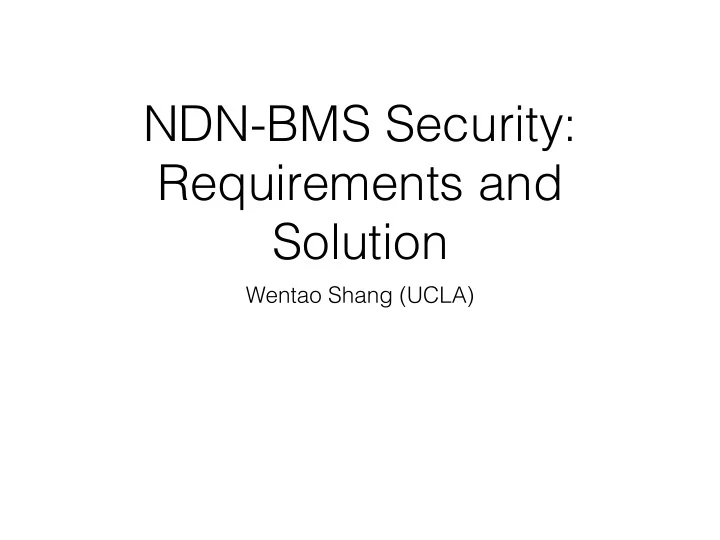

NDN-BMS Security: Requirements and Solution Wentao Shang (UCLA)
Application scenario • NDN-BMS collects sensor data from UCLA campus and publishes the data into an NDN repo • Multiple users have access to the data • Different users have different access privileges
Security requirements • Authenticity & Integrity: each data packet is verifiable • Confidentiality: only authorized user can access BMS data • Scalability: security mechanism need to scale to a large number of users
Current solution • Authenticity & Integrity: • Every data packet is signed by the data publisher (a gateway connected to sensors) • Gateway’s public key is certified by some higher- level authority (e.g., building manager), which is certified by the top manager (using the root key) • Every entity in the system trusts the root key
Current solution • Confidentiality: encryption-based access control • All BMS data is encrypted with a symmetric key • Users gain access to the data by acquiring the encryption key
Encryption key distribution • Users are identified by their public keys • The data encryption key (DEK) is encrypted by the authorized user’ public key and published as normal NDN data • DEK is updated periodically, or whenever a user changes privilege (e.g., adding or dropping access to some data)
Scalability issue in DEK management • The first prototype publishes DEK for each user as a separate data packet • O(n) RSA encryption and O(n) RSA signing • A simple optimization: pack all encrypted DEKs into a single data packet • O(n) RSA encryption and O(1) RSA signing
A better(?) solution • Recommended by RFC 2627: hierarchical key management (designed for secure multicast) DEK E(K1, DEK) E(K2, DEK) K1 K2 E(K3, K1) E(K4, K1) E(K5, K2) E(K6, K2) K3 K4 K5 K6 E(U2, K3) E(U1, K3) User1 User2 User3 User4 User5 User6 User7 User8
Scalable user deletion • O(log(n)) updates vs. O(n) updates in old scheme • Cost: more keys to manage & transmit DEK’ E(K1, DEK’) E(K2’, DEK’) K1 K2’ E(K5’, K2’) E(K6, K2’) K3 K4 K5’ K6 E(U6, K5’) User1 User2 User3 User4 User5 User6 User7 User8
Other issues • Selection of cryptography • Symmetric vs. asymmetric encryption • HMAC vs. RSA signing • Hierarchical access control
Summary • Encryption is the most effective access control for NDN applications • Multicast security may be a useful reference • Hierarchical access control is a new challenge
Recommend
More recommend